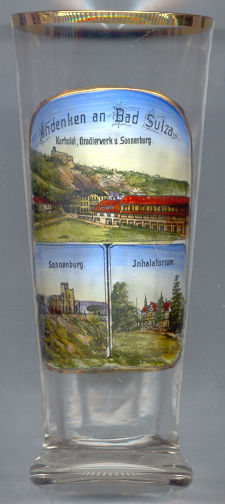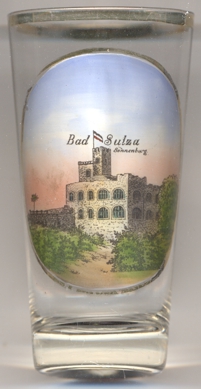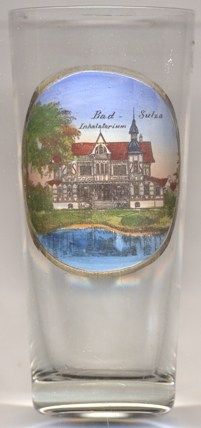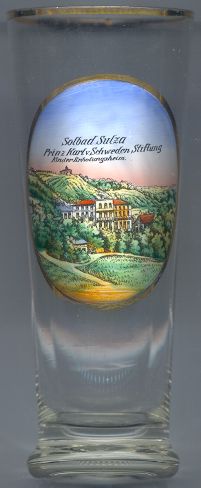

|
| DEUTSCHLAND | GERMANY |
| Bundesland: Freistaat Thüringen | Thuringia |
| Landkreis: Weimarer Land |
 Bad Sulza is situated at an elevation of 139 m at the Ilm river in eastern Thuringia.
A castle (buchwardum Sulza) was already mentioned in 1046.
Salt production at this place is documented at least since 1064.
By 1353 Sulza had obtained the status of a town (oppidum Sulcz).
The oldest facilities to increase the salt content of the saline were built in 1560. After 1600 the saline
was relocated to its present location. After a severe flood in 1613 the saline began to flourish again only slowly.
A new era began when new saline springs were developed in 1752 and three large thorn houses had been built (see below).
SInce that time the saline was also used for inhalations. Johann Wolfgang von Goethe visited Sulza in 1828 and recommended
the saline for therapeutic uses. The spa was founded in 1847.
Deep bore holes at Darnstedt opened up more profitable saline springs in 1893/96 and 1937.
During World War II Bad Sulza was the site of a POW camp (Stalag 9C).
Salt production was stopped in 1967 but Bad Sulza remained a popular spa place, which was recognized as a state spa in 1995.
A copy of Goethe's garden house in Weimar, originally created for Weimar's activities as
European Cultural Capital 1999, was set up at Bad Sulza in 2001.
Bad Sulza is situated at an elevation of 139 m at the Ilm river in eastern Thuringia.
A castle (buchwardum Sulza) was already mentioned in 1046.
Salt production at this place is documented at least since 1064.
By 1353 Sulza had obtained the status of a town (oppidum Sulcz).
The oldest facilities to increase the salt content of the saline were built in 1560. After 1600 the saline
was relocated to its present location. After a severe flood in 1613 the saline began to flourish again only slowly.
A new era began when new saline springs were developed in 1752 and three large thorn houses had been built (see below).
SInce that time the saline was also used for inhalations. Johann Wolfgang von Goethe visited Sulza in 1828 and recommended
the saline for therapeutic uses. The spa was founded in 1847.
Deep bore holes at Darnstedt opened up more profitable saline springs in 1893/96 and 1937.
During World War II Bad Sulza was the site of a POW camp (Stalag 9C).
Salt production was stopped in 1967 but Bad Sulza remained a popular spa place, which was recognized as a state spa in 1995.
A copy of Goethe's garden house in Weimar, originally created for Weimar's activities as
European Cultural Capital 1999, was set up at Bad Sulza in 2001.
The  Gradierwerk (thorn house) [left, no. 1668: top picture, right] was used to increase the salt content of the saline
by letting the waters run over blackthorn rods. The evaporating waters still contain some salt so that the air near the thorn house
is humid and salted, which became the basis of the spa.
Until the early 20th century Bad Sulza had three thorn houses, all built between 1752 and 1755.
The Gradierwerk "Friedrich" was demolished in 1936, the Gradierwerk "Charlotte" was torn down in 1956. The Gradierwerk "Louise",
built in 1754, is still in use, although it had to be reconstructed after damages by a storm in 1925 and a fire in 1981.
Gradierwerk (thorn house) [left, no. 1668: top picture, right] was used to increase the salt content of the saline
by letting the waters run over blackthorn rods. The evaporating waters still contain some salt so that the air near the thorn house
is humid and salted, which became the basis of the spa.
Until the early 20th century Bad Sulza had three thorn houses, all built between 1752 and 1755.
The Gradierwerk "Friedrich" was demolished in 1936, the Gradierwerk "Charlotte" was torn down in 1956. The Gradierwerk "Louise",
built in 1754, is still in use, although it had to be reconstructed after damages by a storm in 1925 and a fire in 1981.
The  Kurhotel [left, no. 1668: top picture, centre background]
was used as the commander's office for the POW camp (Stalag 9C). The building was demolished in 1998.
Kurhotel [left, no. 1668: top picture, centre background]
was used as the commander's office for the POW camp (Stalag 9C). The building was demolished in 1998.
 The ruins of
The ruins of  castle Sonnenburg [near left, no. 4074, and far left, no. 1668: bottom left]
are apopular tourist attraction. Alhough a castle at this place had been mentioned in 1046, the ruins as we see them today
are not very old. The romantic artificial ruins were built in 1907–1908 and were used as a summer restaurant. Although the
ruins were renovated in 1993, the restaurant was closed in 1995.
castle Sonnenburg [near left, no. 4074, and far left, no. 1668: bottom left]
are apopular tourist attraction. Alhough a castle at this place had been mentioned in 1046, the ruins as we see them today
are not very old. The romantic artificial ruins were built in 1907–1908 and were used as a summer restaurant. Although the
ruins were renovated in 1993, the restaurant was closed in 1995.
 The
The  Inhalatorium [far left, no. 1668: bottom right, and near left, no. 4075] was built in 1903.
Until the early 1990s the building was used for its original purpose, inhalations with saline from the Carl-Alexander-Sophien spring. Afther thorough
renovation works between 1993 and 1999 the building is now used by the Bad Sulza spa guest information, a library and other facilities.
Inhalatorium [far left, no. 1668: bottom right, and near left, no. 4075] was built in 1903.
Until the early 1990s the building was used for its original purpose, inhalations with saline from the Carl-Alexander-Sophien spring. Afther thorough
renovation works between 1993 and 1999 the building is now used by the Bad Sulza spa guest information, a library and other facilities.

The picture on glass no. 1958 [left] shows the
 recreation
recreation
![[scale]](lineal.jpg)